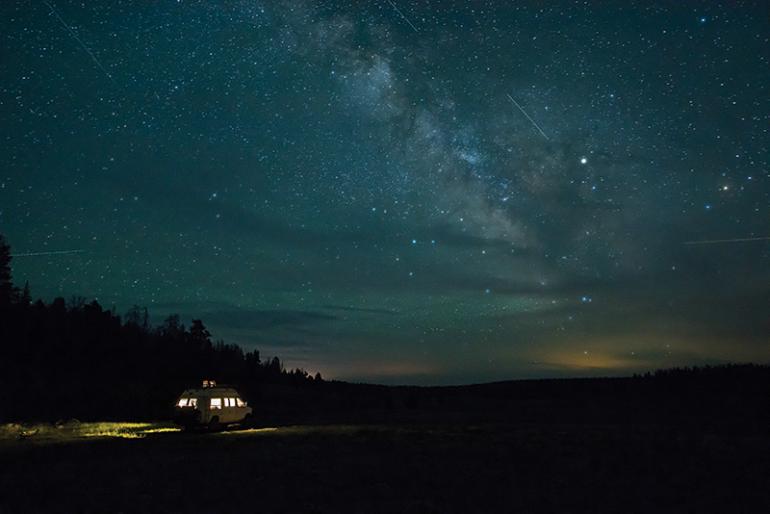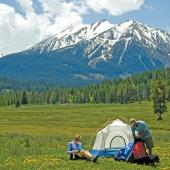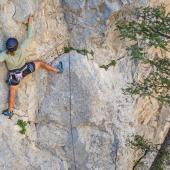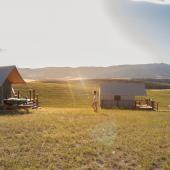Basecamp Buggies
Soon after we’d discovered that the rooftop “emergency exit” on our truck camper was actually a hatch to the party roof, the landscape stopped me in my tracks. Drinking a cold beer and watching the clouds shift as the brook trout and rare fluvial grayling rose in a nearby stream was all part of a dream come to fruition. Up Wise River, on a tributary near a trailhead where we planned to hike to some alpine lakes, I was happy.
My wife and I had bought an adventure-mobile. We settled on a 1999 one-ton Ford pickup with a 1993 Lance truck camper. The Bison, as I called it, had a big ol’ diesel engine, off-road tires, ground clearance, and four-wheel-drive. The camper had a gas stove, furnace, air conditioner, fridge, toilet, shower, a 39-gallon water tank, and a pillowtop queen mattress. It was bear- and lightning-safe (aluminum sided), energy independent (equipped with solar panels), and actually pretty badass. The stereo thumped. It didn’t even have any of those swooshy RV graphics.
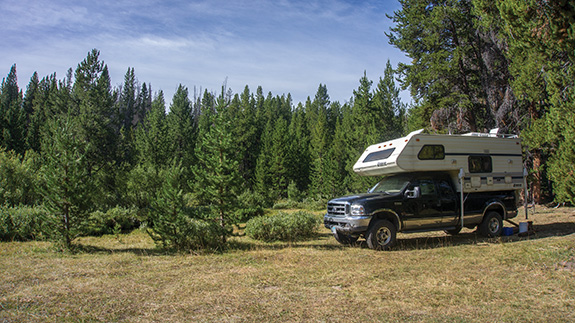
On the other hand, we bought a 25-year-old beast that hemorrhaged water, had a hole in the driver’s door, rode like a dump truck, occasionally responded to the steering wheel, had a turning radius the size of a roundabout, and was pocked with hail damage.
We’d considered everything from a VW bus or built-out Sprinter to a converted Sportsmobile 4x4 van, pull-behind camper, canvas outfitters tent, truck-top tent, or Toyota Dolphin. We liked the detachability of the camper, the ground clearance of the truck, and the fact that we could still pull our raft.
But it didn’t take long for concern to set in. On one of our first trips, three of the four turnbuckles (the metal bars that keep the camper connected to the truck) came off on the bumpy drive. The fridge had jostled open and food was everywhere. We found a campsite and started to detach the camper so we could continue up the increasingly bad road to a mountain lake when the pigtail electric connection popped off the camper. And as we raised the camper off the truck bed, one of the jacks buckled and we nearly tipped the camper—that same jack ceased to raise or lower afterward. We were miraculously able to get the camper back on the truck, but our frayed nerves made it hard to enjoy the rest of the trip.
On subsequent outings, it seemed like we were always searching for some piece of the Bison that rattled off, and we learned a lot about adventure-mobiling. For example, don’t count on much time for other hobbies after you buy an old RV. Expect a huge adjustment to your new life with a decked-out road-trip rig. Expect things to go wrong, every time you roll out of the driveway. And get ready for long, wonderful weekends in beautiful, remote spots all around Montana.
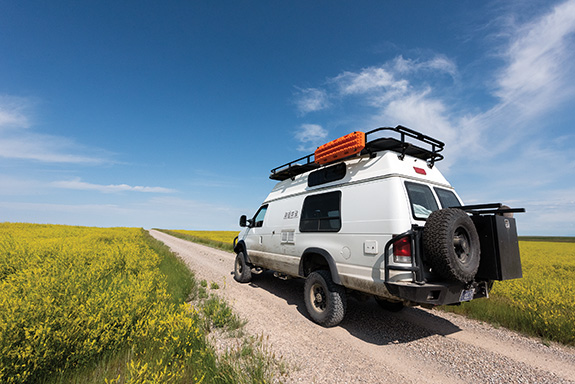
Getting Started
Many factors come into play when thinking about the set-up that’s right for you. For example, it should be spacious enough for your crew. A truck camper was perfect for me, my wife, and our dog, but when we wanted to show family and friends how we were livin’, it made for short trips and occasional grumpy moments.
If you intend to take your adventure rig on unimproved roads, it needs adequate ground clearance. The whole point is to spend time at life-giving backcountry locations, many of which are accessible only via rocky, unmaintained roads. You’re only as high as your lowest point; our F-350’s low-hanging rear differential ended up being an unforeseen limiting factor. If going on Jeep trails is part of your ideal trip, an off-road trailer behind a Rubicon or a Tacoma with a high-rise topper might be good.
Determine which creature comforts are not negotiable. The built-in bathroom, furnace, and propane oven were some of our favorites, but you can save valuable space and weight if you’re comfortable with cat holes, have zero-degree sleeping bags, and cook on a stove or grill.
Consider your comfort level with genuine backcountry dangers. Of course, almost nothing is truly safe from a pissed-off griz (and the odds of an encounter are low), but a fully hard-sided rig to cook and eat in can give some peace of mind. And an aluminum-sided craft will act as a faraday cage, protecting inhabitants from lightning. We slept better in our metal-walled camper.
Expect things to go wrong, every time you roll out of the driveway. And get ready for long, wonderful weekends in beautiful, remote spots all around Montana.
If bringing trailered toys is a priority, make sure your adventure-mobile isn’t already a pull-behind camper, and that its engine is strong enough. Triple-towing and strapping a raft atop your rig are possibilities, but far from ideal.
If it’s not detachable, you’ll have to drive the whole hacienda from your campsite back up or down bumpy roads to boat ramps and trailheads. Accoutrements need to be safely stowed each time, and you may have to leave at least some gear back at camp.
Some of the most capable and equipped adventure-mobiles can cost six figures (as if saving up for a house in Bozeman isn’t hard enough). We proudly went the cheap route but I’m not sure I’d endorse it. Still, while we all want an enviable adventure-mobile, don’t blow your emergency fund on something that doesn’t spark joy, either.
Unless you’re handier than I am, you’ll want it to be ready to roll upon arrival without needing modifications or repairs. If you have to pair the camper with the vehicle, do that research before signing over any money.
Other factors might be important to you, like engine life, maintenance required, and unwieldiness driving in town and on narrow roads. A thoughtful decision can make for a long relationship.
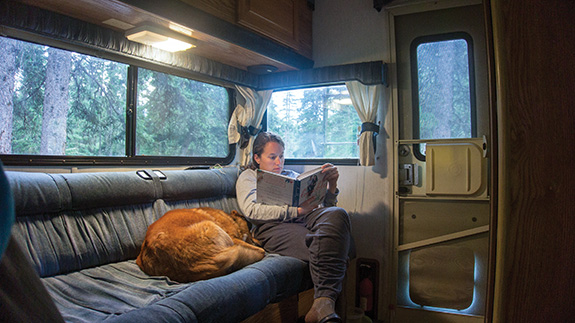
Tips & Tricks
Camping on public land, but not in designated campgrounds, is known as dispersed camping. It’s a free and under-utilized option to set up a base camp. Most national forests allow dispersed camping in some form, though in many places it’s limited to the already-worn spots that have fire pits. In springtime, many of the best dispersed campsites are under snow or are muddy—see the sidebar for some locations.
Camping at dispersed sites means being self-sufficient. Bring enough water; a deep-cycle battery for power; propane for heat, for the fridge and for the stove (a 20-pound cylinder lasts longer than you’d probably guess); and a plan for pooping. If you’re going to be out for more than a few days, consider a solar panel to recharge the battery. But if it’s mounted to your roof, you’ll also have to park in the sun, which can make the interior uncomfortably hot in high summer. If you value privacy (like me), have an ill-behaved dog (like me), or like to get a little rowdy (not unlike me), dispersed camping is a good option.
As previously mentioned, adventure-mobiles and boats don’t always work together. You can go the camper-as-part-of-your-vehicle route (camper van, motorhome, truck camper, etc.) so that you don’t have to triple-tow, but this means you have to take your living quarters back down the bumpy road and then on the sometimes-steep slope of the boat ramp. Salt-and-pepper shakers slide off the counters, gear is left unattended at your campsite, and nerves can get frayed before you tie your first knot. And anyone who’s owned a truck camper will tell you that detaching it is not as easy as it seems.
Rubbermaid bins and Yak boxes are your friends. The rugged roads that lead to the cool spots around Montana are not always kind to outdoor equipment, so keeping it in tightly packed containers is best. Plus, those big plastic bins can double as tables on your campsite’s “patio.”
Be excited for the upcoming experiences, but also be prepared for the reality to fall short of the dream. We often idealize this lifestyle without considering what can and will go wrong. Don’t let these unpleasant surprises ruin your otherwise extraordinary outings.
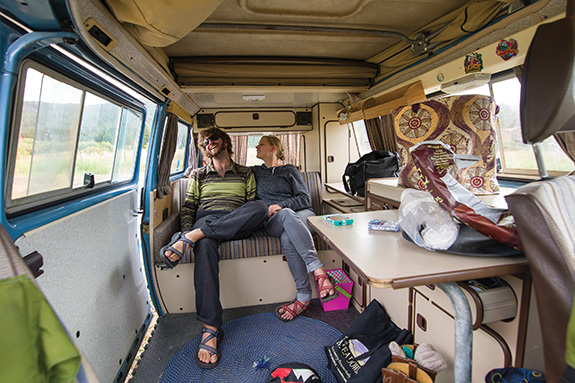
Life on the Road
Once you’re safely parked and unloaded, your dog is curiously exploring, and a beer is in hand, the earned euphoria can commence. Pine-filtered alpine air is all you need now. Some of our best days with the Bison were spent in a hammock reading McGuane’s short stories or listening to the MeatEater podcast safe from the wind and rain. Other times, memories were made: stunning sunsets viewed from a quiet campsite, barely crawling to my sleeping bag after a 15-mile hike in the Madison Range, and reminiscing over the day’s big-fish moments while dinner sizzled on the stove.
As Annie Dillard said, “How you spend your days is how you spend your life”—and days spent base-camping from a portable cabin can be some of the best. Though obstacles, frustrations, and anxieties are part of adventure-mobile ownership, these rigs also provide once-in-a-lifetime opportunities to live our best lives.
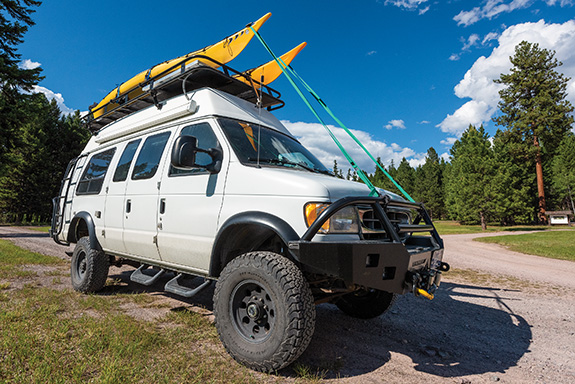
On the way home from our aforementioned disastrous trip, we actually saw a similar truck camper totaled on the shoulder of the highway. It seemed like an apt summation of that weekend but it was also a stark reminder that things could always be worse. It wasn’t long after that we decided to part ways with our truck camper in favor of Forest Service cabins, and further contemplation about our ideal adventure-mobile. But we’ll never forget the magical (and sometimes exasperating) days and nights in the Bison.
Choose Your Own Adventure
All would-be adventure-mobilers have specific wants, needs, and budgets. Here are some general pros and cons for common rig options.
Built-Out Sprinter Van
Pros: Spacious, amenities, bear-safe, can tow, cool factor, long engine life if it’s diesel.
Cons: Lacks ground clearance, not detachable, expensive (often prohibitively), you’ll look like every other apish #VanLifer in Bozeman.
Full-Sized Motorhome
Pros: Spacious, amenities, and bear-safe, can tow, comes ready to roll.
Cons: Lacks ground clearance, often expensive, not detachable, unwieldy (as hell), you’ll likely be nicknamed by fellow campers (and your friends) as “Grandma” or “Grandpa.”
Hi-Rise Truck Topper
Pros: Can tow, ground clearance, potentially and bear-safe, affordable, minimalist.
Cons: Limited space, lacks built-in amenities, basically a hard-sided tent.
Off-Road Trailer
Pros: Ground clearance, and bear-safe, detachable, affordable(ish).
Cons: Limited space, cannot tow, lacks built-in amenities.
Sportsmobile Van
Pros: Ground clearance, amenities, bear-safe, can tow, comes ready to roll, cool factor, 4x4.
Cons: Limited space, not detachable, expensive (often prohibitively), gawkers want to peek inside.
Standard Pull-Behind Camper
Pros: Spacious, detachable, amenities, potentially bear-safe, (typically) affordable.
Cons: Cannot tow, unwieldy, typically lacks ground clearance (some models offer higher clearance), impresses no one.
Trendy Truck-Top Tent
Pros: Can tow, ground clearance, affordable.
Cons: Limited space (and tough to get dogs up the ladder), lacks built-in amenities, not bear-safe.
Truck Camper
Pros: Ground clearance, amenities, potentially bear-safe, can tow, detachable (though it’s often horrifying), can be affordable.
Cons: Limited space, need to match camper with truck, takes corners on two wheels (top-heavy), lots of miscellaneous problems.
VW Bus or Toyota Dolphin
Pros: Amenities, bear-safe, comes ready to roll, cool factor.
Cons: Limited space, lacks ground clearance, cannot tow (or even handle mountain passes effectively with these wimpy engines), not detachable, can be expensive, often reek of patchouli.
Practice Makes Perfect
It’s wise to test your new rig out closer to home, working out the kinks while minimizing the consequences. Many public-land campgrounds in our area thaw out and open up in the spring. Look for low-elevation spots this time of year, as even the foothills can be muddy and slathered in snow. Here are a few nearby places to explore. —JB
Paradise Valley
Many fishing-access sites allow camping in the spring, such as Mallard’s Rest, Loch Leven, and Dailey Lake. Pre-runoff fishing on the Yellowstone can be lights-out, especially if you happen to hit one of the spring hatches like baetis or Mother’s Day caddis. Climbers can usually find dry rock at Allenspur near Carter’s Bridge, while paddlers can take their pick from one of the numerous breathtaking stretches of water. The surrounding Absaroka (Western Beartooth) and Gallatin mountains look their majestic best on bluebird days, but be aware that Paradise Valley is a bit of a wind-funnel and 40-mph winds are not uncommon.
Bear Trap Canyon
This Bozeman favorite is located in a banana belt, meaning it avoids much of the snow and bitter cold that stymie other southwest Montana locales. As such, it’s a great spring camping area. There are multiple BLM campgrounds and campsites, some of which are dispersed and free, while others start collecting fees on April 1. Spring fishing on the Lower Madison is often fantastic, trail runners can find decent footing up the canyon, and climbers can cross the river and trundle down to Neat Rock for some early-season ascension. It’s also often windy.
Yellowstone Park
Many of the Park’s campgrounds are closed until June, but Mammoth Campground stays open year-round, Madison Campground opens in late April, and Norris and Canyon open in mid-May (the West Entrance opens to vehicles on April 17 and the North Entrance is open year-round). Yellowstone is higher in elevation than the other spots listed here, so spring can hang on a bit longer. But the throngs of tourists won’t have arrived yet and the snow-covered peaks glow with a particular luminance in the early season. Bears and bear cubs emerge from hibernation and, as always, geothermal features dazzle the eye. Fishing season opens on the third Saturday in May.
Try Before You Buy
Fear commitment? Why buy the cow when you can milk it free—or, at least, for a fraction of thep rice? Hatch Adventures in Bozeman and Tierra Traveler in Livingston both rent adventure-mobiles by the day, week, or month. Try one of each style—a 4WD Jeep or Tacoma with built-in pop-up from Hatch (like the one on the cover) or a decked-out Sprinter van from Tierra—and get some invaluable experience before you shell out tens of thousands on your own rig.


